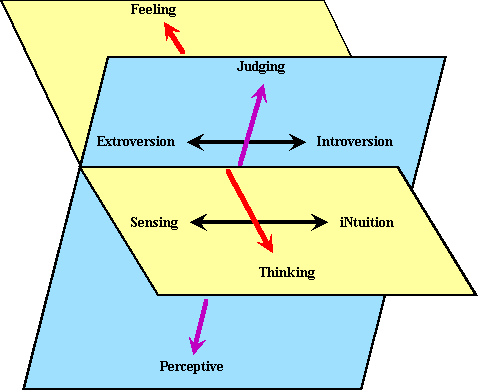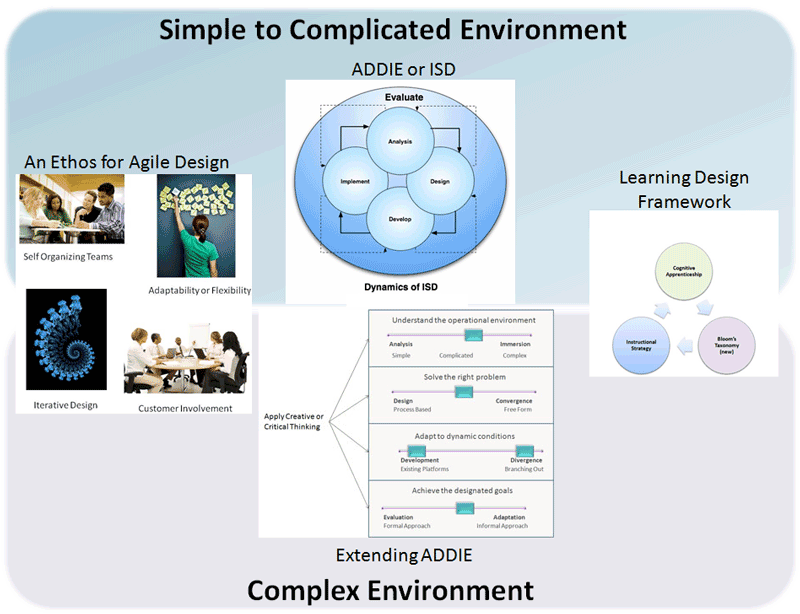Carl Jung and Myers Briggs Type Indicator
During the early 1900s, Carl Jung established a field identifying distinct personality patterns. Many theorists have since broken these patterns into categories attempting to make them easier to understand. Carl Jung was a contemporary of Sigmund Freud and a leading exponent of Gestalt personality theory. Jung developed a ground-breaking personality theory that introduced two attitudes: extroversion and introversion (1933a).
Later he described human behavior as a combination of four psychic functions: thinking verses feeling and intuition verses sensation (1933b). Thinking and feeling are said to be rational functions because they both require acts of judgments. Sensation and intuition involve immediate experiences. The MBTI, Kolb's Learning Style Inventory, the Managerial Grid, and a number of other instruments all use a form of extroversion/introversion. His four other functions are also closely tied with these instruments.
The MBTI has been claimed (McCaulley, 2000) to be an aid in understanding the individual differences by helping employees and managers enhance their interpersonal relations and thereby improving their ability to work effectively. Thus, having knowledge of coworkers' personality preferences, or MBTI type, will facilitate greater respect for individual differences, aid in assigning work responsibilities, and foster effective collaboration among employees. However, McCaulley offered little empirical evidence to support those claims. This is why it is more complicated than the other models discussing learning styles as they are strictly learning models where the MBTI is a personality model. However, supposedly our personality plays a part in determining our learning style, thus it ties in with the other models so it will be discussed as a part in the learning process.
The relevant data does not justify the conclusion that the MBTI is a direct measure of Jung's theory of personality types and the current scoring procedures for the MBTI does not allow one to make important prophecies about individuals (Pittenger, 2005). Pittenger argues that the available evidence suggests that the MBTI does measure constructs related to personality. Thus, the MBTI, while offering much intuitive appeal, may not yet be able to support all the claims its supporters make.
Scores obtained from the MBTI indicate a person's preference on each of four dichotomous dimensions:
- Extroversion (E) versus Introversion (I) [similar to two dimensional behavioral models and Kolb's Learning Style Inventory]
- Sensing (S) versus iNtuition (N)
- Thinking (T) versus Feeling (F) [similar to two dimensional behavioral models and Kolb's Learning Style Inventory]
- Judging (J) versus Perceiving (P)
1. Extroversion (E) versus Introversion (I)
This indicates whether a learner prefers to direct attention towards the external world of people and things or toward the internal world of concepts and ideas. This preference tells us from where people get their energy.
Introverts find energy in the inner world of ideas, concepts, and abstractions. They can be sociable but need tranquility to regain their energy. They want to understand the world; they concentrate and tend to be reflective thinkers. They think more than talk. Introverted learners want to develop frameworks that integrate or connect the information that they learn, this becomes knowledge is the interconnection of the material and to see a global view.
Extroverts find energy in things and people. They prefer interaction with others, and tend to be action-oriented. They also tend to think on their feet. They talk more than listen. Extroverted learners learn by teaching others. They do not normally understand the subject until they try to explain it to themselves or others (working in groups). Problem Based Learning and Collaborative Learning are good teaching techniques for this group.
2. Sensing (S) versus iNtuition (N)
This indicates whether a learner prefers to perceive the world by directly observing the surrounding reality or through impressions and imagining possibilities.
Sensing people choose to rely on their five senses. They are detail-oriented, they want facts, and they trust them. Sensing learners prefer organized, linear, and structured lectures (systematic instruction or step-by-step learning).
Intuitive people seek out patterns and relationships among the facts they have gathered. They trust hunches ("sixth" sense) and their intuition and look for the "big picture." They also value imagination and innovation. Intuitive learners prefer various forms of discovery learning and must have the big picture (metaphors and analogies), or an integrating framework in order to understand a subject. They like concept maps or and often compare and contrast tables.
3. Thinking (T) versus Feeling (F)
This indicates how the learner makes decisions, either through logic or by using fairness and human values.
Thinkers decide things impersonally based on analysis, logic, and principle. They value fairness - focusing on the situation's logic, and placing great weight on objective criteria in making a decision. They naturally see flaws and tend to be critical. Thinking learners prefer clear goal and objectives. They want to see precise, action-oriented cognitive, affective and psychomotor objective. They also want to know what they have to do to learn the material.
Feelers value harmony by focusing on human values. They focus on human values and needs as they make decisions or arrive at judgments. They tend to be good at persuasion and facilitating differences among group members. They value empathy and harmony. Feeling learners enjoy the small group exercises, especially harmonious groups.
4. Judging (J) versus Perceiving (P)
This indicates how the learner views the world, either as a structured and planned environment or as a spontaneous environment.
Judging people are decisive, self-starters and self-regimented. They also focus on completing the task, knowing the essentials, and they take action quickly. They plan their work and work their plan. Deadlines are sacred as they see time as a finite resource. Judging learners need tools that help them to plan their work and work their plan. They want guides that give quick tips. They can be encouraged by offering self-improvement.
Perceptive learners are curious, adaptable, and spontaneous. They start many tasks, want to know everything about each task, and often find it difficult to complete a task. Deadlines are meant to be stretched while more information is gathered as they see time as a renewable resource. They like to leave their options open. Perceptive learners often postpone doing an assignment until the last minute. They are not lazy; they are merely seeking information up to the very last minute. Breaking down a complex project into a series of sub-assignments and providing deadlines will keep perceptive learners on target. Also they are often process oriented (emphasis is on how the task is completed) and will easily adapt as long as they know the how.
MBTI Model
The MBTI model would have two dimensions - height and width, similar to Kolb's and other models, but it would also have a third dimension - depth. Extroversion/Introversion would be on the horizontal axis, while Feeling/Thinking would be on the vertical axis. This is represented by the model below.

MBTI Model
The depth (third dimension) of Extroversion/Introversion (EI) would be Judging/Perceptive (JP). This might be thought of as how much time (JP) we are willing to stick to a task (EI) rather it be actively engaging in it or reflecting on it.
The depth (third dimension) of Feeling/Thinking (FT) would be Sensing/iNtuition (SN). This might be thought of as using our various senses, to include our "sixth sense" (SN) when thinking or feeling (FT) about a subject.
References
Coffield F. J., Moseley D. V., Hall E., and Ecclestone K. (2004). Should we be using learning styles? What research has to say to practice. London: Learning and Skills Research Centre/University of Newcastle upon Tyne.
Jung, C. G. (1933). Psychological Types. New York: Harcourt, Brace.
Jung, C. G. (1933). Modern Man In Search of A Soul. New York: Harcourt, Brace.
McCaulley, M. H. (2000). Myers-Briggs Type Indicator: A bridge between counseling and consulting. Consulting Psychology Journal: Practice and Research, 52, 117Ð132.
Pittenger, D. J. (2005). Cautionary Comments Regarding the Myers-Briggs Type Indicator. Consulting Psychology Journal: Practice and Research, Vol. 57, No. 3, 210Ð221.



